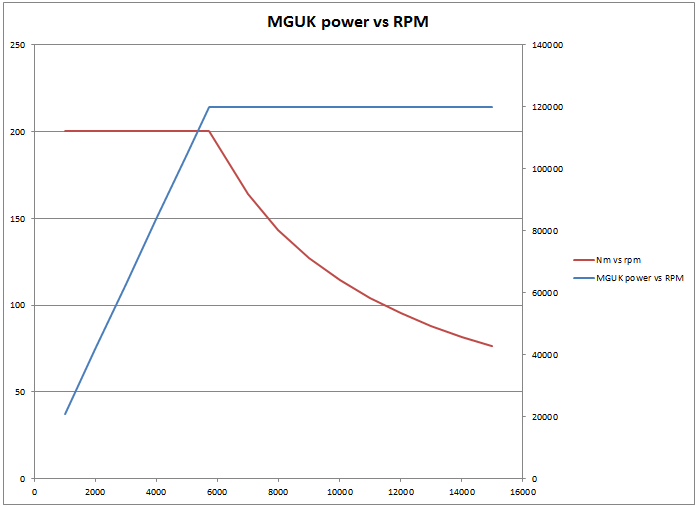I don't see the word power in there. I see torque.wuzak wrote: From the rules:
5.2.3 The MGUK must be solely and permanently mechanically linked to the powertrain before the main clutch. This mechanical link must be of fixed speed ratio to the engine crankshaft.
The rotational speed of the MGU-K may not exceed 50,000rpm.
The maximum torque of the MGU-K may not exceed 200Nm. The torque will be referenced to the crankshaft speed and the fixed efficiency correction defined in Article 5.2.2 will be used to monitor the maximum MGU-K torque.
The laminate thickness of the MGU-K may not be less than 0.05mm.
Torque wont be constant.So, the minimum speed at which the MGU-K can make 120kW/160hp is 5730rpm. Sure the MGU-K can rev to 50,000rpm, but I don't see them maintaining power over a wide range. They tend to have constant torque over a small range, but not constant power.
There is a maximum torque, that doesn't really have any bearing on the power output up to that point. Don't worry yourself about inertia, power to the wheels is power to the wheels. It wont be measured in seconds compared to a turbo spooling. I'm sure you see why 80hp was not allowed at the starts in 2013. Imagine the effect 160hp on request would do?SFA = sweet f**k all
The motor speed has bearing on the power output, since the torque is limited.
The MGU-K has to accelerate the car and the engine. There is a lot of inertia there.
To go from 5,000rpm to 10,000 is doubling the speed of the car. It will be measured in seconds, not fractions of a second.
We i agree to disagree with you here. Because what you are saying will eventually happen.Making boost is obviously the goal - you want to get the engine out of its off boost/lag condition. Making boost early and without lag will make the whole car more responsive and move down the track faster.
So you know what materials the turbine will be made out of already and the inlet and exducer nozzles? I', not saying you are wrong, but i cannot speak to it as i've not seen the cars. I'll just wait till the 28th.In normal turbo design the turbine is matched to the compressor. That is not the case here. The turbine will produce more power than the compressor needs when the engine is above an operating point where a normal turbine would be balanced. The turbine is physically larger than a normal turbo's and will have much more inertia.
You are contradicting yourself. why are you talking about energy in this context. Power is what you should be looking at. It seems you are saying that unlimited amounts of energy can be sent to the MGUH, so why are you sending more than 4MJ of energy at more than 160hp just to spin a compressor?I, again, remind you that the energy transfer from the ES to the MGU-K is limited to 4MJ (in reality it is 2MJ, unless you are storing another 2MJ from the MGU-H) per lap, whereas the ES can transfer unlimited amounts of energy to the MGU-H.
Is that what you are implying?





